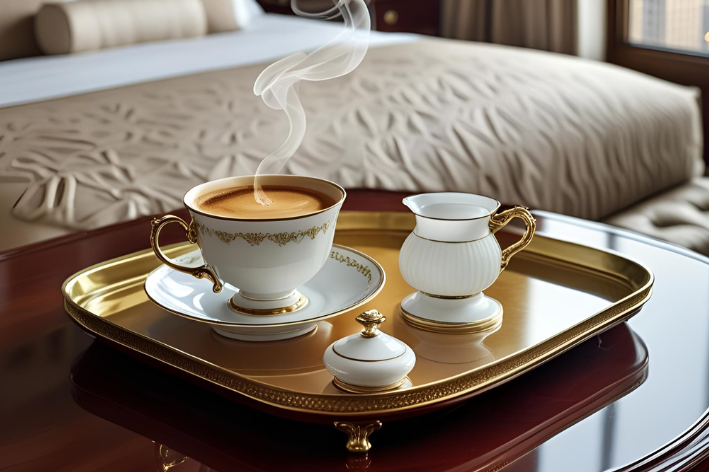Edition OS&E #2: The in-room courtesy tray
A logistical headache for project managers, a time sink for hotel operators — selecting operational equipment (OS&E) in high-end hotel projects often feels like running an obstacle course. This long and meticulous process is usually handled by operational teams aiming to ensure a smooth and coherent guest experience. But they also have to reconcile their choices with the architect’s aesthetic vision — which can sometimes clash with functional or durability requirements.
In-room coffee machines, courtesy trays, kettles, bathroom scales, towel hooks… These items are essential to guest comfort, yet paradoxically among the hardest to select. Not because they’re rare, but because the right models — those that are visually appealing, durable, suited to intensive use and aligned with the hotel’s standing — are buried in an overwhelming array of options.
To support hospitality professionals in navigating this complexity, FIGURZ is launching a monthly editorial series: a regular feature to help the industry sort through household, professional, and often unsuitable references — and make better choices, faster.
After covering in-room coffee machines in our first edition, this month FIGURZ turns its attention to one of their most discreet yet essential companions: the courtesy tray.
Often perceived as a mere detail, the courtesy tray is in fact one of the first material touchpoints between the guest and the hotel’s in-room food and beverage offering. Unlike minibar items, the products on the courtesy tray are free of charge and replenished daily. It supports a daily ritual for many guests: preparing a cup of coffee or tea. When well-designed, it disappears seamlessly into the room’s layout; when poorly integrated or damaged, it becomes a source of frustration. A courtesy tray serves both a practical purpose — protecting furniture — and an aesthetic one, organizing items that otherwise have no place sitting out on bedroom furniture.
What makes a good courtesy tray ?
Here are the key criteria we use to assess a courtesy tray, regardless of the hotel’s market segment:
It should protect furniture from splashes, stains and marks left by cups or spoons.
It should consolidate all beverage essentials: mugs, glasses, spoons, a kettle, and possibly a coffee machine.
From 5-star classification onwards, Atout France regulations make the courtesy tray mandatory, including consumables such as tea, coffee pods, sugar, and milk.
It should be integrated into the room design, matching materials and color tones. Early alignment with the architect is critical to ensure visual harmony.
It must be easy to clean, with no inaccessible corners or materials that easily show stains.
In business hotels, standardization is key — guests expect the same setup in every room.
Avoid mirrored trays: they’re fragile, prone to tarnishing from humidity, and show every smudge.
Always plan for spares. These items often get damaged, broken, or stolen. For custom trays, it’s smart to coordinate with maintenance teams in case repairs are needed.
Most importantly: plan the tray’s location during the design phase. A tray without a dedicated spot will end up misplaced or underused.
Three trays, three hotels: a field study
Budget independent hotel
In smaller, often family-run or economy-chain properties, a courtesy tray is not required by classification standards. The budget is often minimal — or nonexistent.
When a tray is provided, it reflects an effort to go beyond basic lodging, showing attention to guest comfort. Typically, you’ll find a small basket or drawer box placed on a table. The setup is minimal — two mugs, a couple of tea bags or pods, a spoon — but the intent is clear. The challenge here is to do more with less, keeping things tidy and welcoming.
FIGURZ Tip: Choose a stable, compact, and easy-to-clean box. Keep spare units on hand, as losses or breakages are more frequent when items are not integrated into the furniture.
2. Mid-range business hotel (3–4 stars)
In this segment, guests expect a courtesy tray — often without realizing it. They’ll use it as soon as they arrive or first thing in the morning. These clients are frequent travelers and quickly notice whether such amenities are present.
The tray is usually visible, functional, and placed consistently in all rooms. It may be custom-built and integrated into the furniture — provided the design is aligned with operational needs. A simple change in the mug size or coffee pod reference can render the entire setup unusable.
FIGURZ Tip: For custom designs, align with operations teams early. Define the content clearly and consider removable inserts to accommodate future changes. Always document the model for future replacements or repairs.
3. Luxury leisure hotel (5 stars)
In high-end international hotels, guests dedicate a significant portion of their travel budget to accommodation and expect refinement in every detail.
The courtesy tray becomes a design object. It must be elegant, aligned with the room’s overall ambiance, and functional. The problem? It’s often an afterthought during design phases. As a result, it ends up with no designated spot — sometimes placed awkwardly on a console table or hidden in a closet.
FIGURZ Tip: Integrate the tray during the earliest design stages. Choose high-end materials — wood, leather, brushed metal. The tray should elevate the in-room ritual, not merely contain it.
In summary
There’s no one-size-fits-all courtesy tray. The best ones are thoughtfully designed for a specific guest profile, context, and operational flow. The right choice depends on the hotel’s positioning, the content to be presented, the room design, the product’s durability — and, most of all, proper planning from the beginning of the project.
The courtesy tray may be a small detail, but it speaks volumes about the attention paid to guest experience.
Coming up next…
In our next edition, we’ll focus on another too-often overlooked yet vital detail in hotel room comfort: the bathroom hook — that small but indispensable item that guests look for instinctively.

